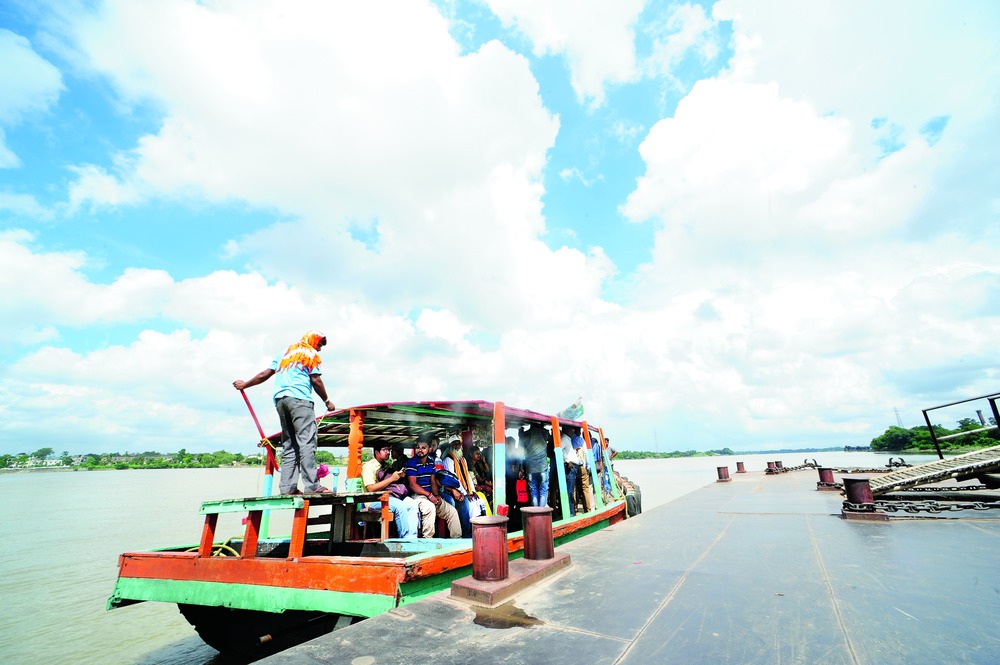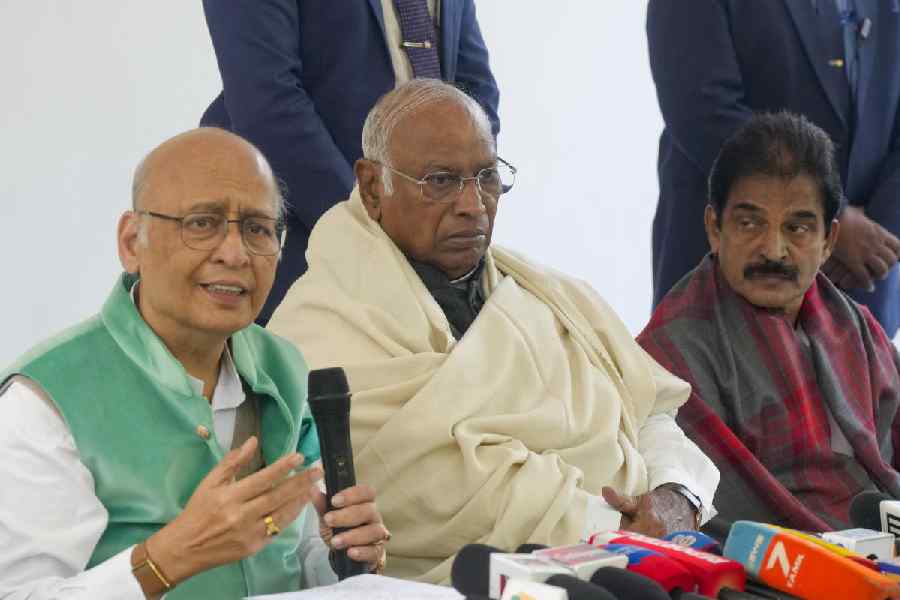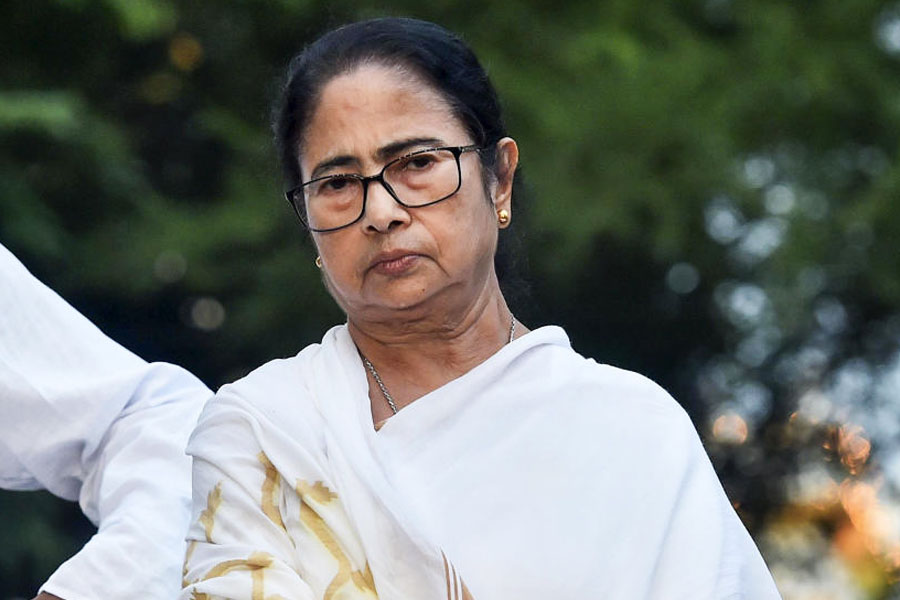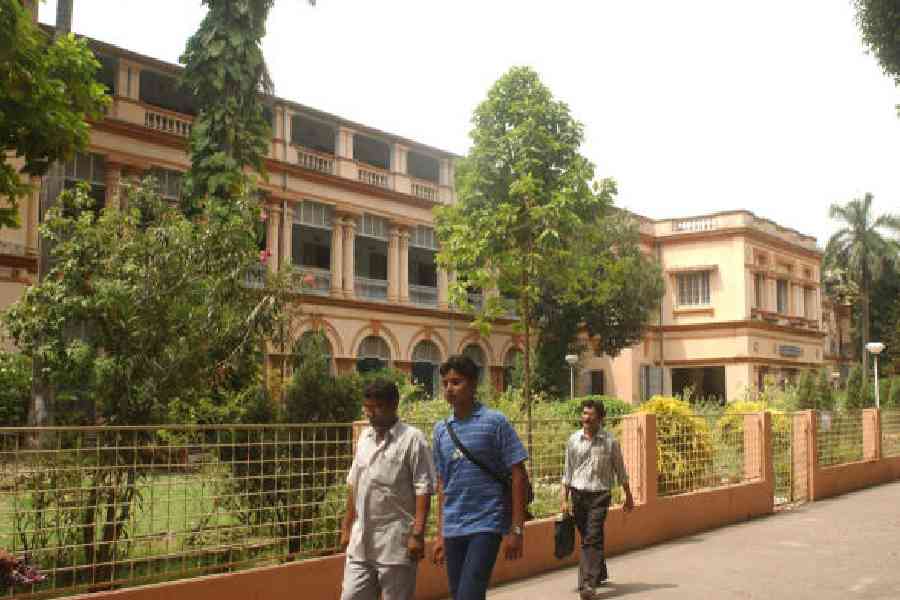

A weekday afternoon, about three. There is no buzz around Fairlie Place. A lone steamer is waiting at the jetty, there is another one moored at a distance; you can see one man getting dressed, another man is peering into the window of the driver's cabin on the top deck and combing his hair, a third is heaping rice on plates. The air is balmy and the coffee-coloured waters of the Hooghly, languid. Even the leaves of the bot and chhatim trees at the ghat are unmoving. It is a lazy, lazy afternoon.
About 35-40 of us lumber onto the steamer for Ramkrishnapur. There is one every 15 minutes. A ride costs five rupees. There is a family of four, definitely on vacation, click-clicking selfies; one or two couples, intertwined like live wires; a student from Calcutta University with a backpack and Bieber hair, and a babu with a pile of pink and yellow files.
Ramkrishnapur is a small township on the Hooghly, north of Shibpur. "It takes only 15 minutes from here," says Jaydeep Phode, a middle-aged boatman. By road, from any place in central Calcutta it takes about 45 minutes to an hour. "We wait at the ghat for another 15 minutes and then come back," says Phode who ferries passengers on this route at least 20 times a day. He has been doing this for the last 15 years. " Koto lok aashe jaye. Men and women in service, students... They retire, they grow up," he philosophises, his sing-song voice in perfect sync with the rest of the setting.
In Calcutta, ferry services may be an alternative mode of transport, but in many parts of rural Bengal they are the only connection with the mainland even today.
"The lyrically named interior islands of the South 24-Parganas - Kaikhali, Sunderbans, Sajnekhali, Pathar Pratima - and the dweeps of Gosaba do not have much of a road network," says a senior official of the Sundarban Development Board, who does not want to identify himself.
Sunanda Jana lives in Kakdweep and sells vegetables for a living. "I was a child when I used to go to Raidighi from Kakdweep every day to sell vegetables with my mother. We would take the launch. It would take us an hour and 45 minutes to reach the market. The temporary bridges [constructed between the islands, over the river, during the dry months] would vanish the minute the monsoons arrived, and we would be left stranded," she recalls. And adds, "That was 40 years ago. Today, my granddaughter takes the launch at eight in the morning every day to attend college in Raidighi."
This is the Year of the Inland Waterways. The Bengal Government has so named it as part of its revamp-riverine-transport initiative, an attempt to make the most of nature's bounty - a wide network of inland waterways.

Many years ago, the then chief minister Buddhadeb Bhattacharjee had dreamt a "Venice Dream" for Bengal. This year, the Trinamul government allotted Rs 561 crore to the transport department for this project. Its sweep includes the creation of 76 new jetties, restoration of 116 existing ones, modernisation of ghats and deployment of new vessels.
Rajib Poddar is a small-time businessman. He has to travel to Metiabruz thrice a week. "By road it takes three hours. There are too many red signals, congestion on the highway and pollution. I take the ferry service from Fairlie Place to Ramkrishnapur, and thereon from Nazirganj to Metiabruz. All of it takes a little over an hour. Now I hear we will have a direct boat between Fairlie Place and Metiabruz. I will be able to save another half hour."
Indeed, the roads of Bengal are choking with traffic. "If we can develop the east-west passenger service across the Bhagirathi, Hooghly and Jalangi rivers, the situation is likely to improve. The National Waterways 1 (NW-1) that connects Banaras to Haldia Port is already operational for cargo movement. If the same route can be developed to ferry people, passengers would find much relief," says Alapan Bandyopadhyay, principal secretary of the state transport department. NW-1 runs through Uttar Pradesh, Bihar, Jharkhand and West Bengal and is 2,293 kilometres long. Of this, 560 kilometres lie in West Bengal.

Every day, around 40,000 people use the waterways operated by the West Bengal Surface Transport Corporation Ltd and the Hooghly Nadi Jalpath Paribahan Samabay Samity Ltd, according to Bandyopadhyay. Other than this, there are private launch services that operate between the different ghats. In contrast, about 8.5 lakh people use the roads of Calcutta and the adjacent areas each day.
The development and use of inland waterways is a state subject, but the Centre, of late, is all agog with the efficacy of such a project countrywide. Only recently, shipping minister Nitin Gadkari announced that his ministry had sent a proposal to get a part of the Central Road Fund to boost the network of inland waterways. The Centre has also sought the support of the World Bank for the development of six ferry terminals in different cities, including Calcutta.
"Pontoons or floating jetties are being built in a few places to facilitate transport. These jetties will be extended by several metres into the waterfront so that movement of the vessels are not affected during low tides. The pontoons will adjust naturally to the water level and also shift position according to the flow of water, and the vessels will be able to come up to the jetty throughout the day," says Bandyopadhyay.
The existing wooden jetties in many places are unstable and unsafe. "Ganga is a tidal river. During high tides some of these jetties are flooded with water, and after that they are all muddy and slippery and prone to accidents," adds Bandyopadhyay.

Self-propelled double-decker passenger ferries could also ease the heavy traffic, feels Shrey Tayal, director of Riverine Infrastructure and Logistics (P) Ltd, which operates and constructs barrages on the National Waterways. "But we have to keep in mind that the eastern region is price sensitive. So faster modes of transportation will have to be introduced gradually."
S.V.K. Reddy, who is chief engineer of the Inland Waterways Authority of India, brings up the eco-friendly angle. "Passenger vessels are being constructed with bio-toilets in them. We are also planning to use only CNG-based engines instead of diesel," he adds.
Ease traffic, cut down pollution, and now the state transport department is aiming for a third bird with one stone - tourism.
Several private players already operate cruises on the Ganges. Vivada Cruises is one of them. "We run cruises to heritage sites such as Serampore with its erstwhile Danish colony, the Bandel Church, Barrackpore... And if all goes well, two more routes - Calcutta to Dhaka and Calcutta to Tripura - will open up in the next two to three years," says R. Sushila, executive director of Vivada Cruises.

Vivada Cruises plans to run catamarans between Mayapur and Howrah beginning Diwali. Passengers will reach Mayapur in three-and-a-half hours, which is less time than a bus or a train and in double the comfort.
S.K. Dutta lives in Santoshpur, Calcutta. He is associate professor, mathematics, at Rishra College. Earlier, he used to do the two-hour drive down to Rishra from Santoshpur every day. But the last one or two years he has been taking a bus to Khardah and from there, the five-minute ferry ride to Rishra. Khardah to Rishra takes an hour by bus.
For the longest time there was no jetty at Khardah. Commuters had to wade into the river to get into the bhutbhuti. "Every day I take off my shoes and socks when I get off the boat. But that apart, the rest is quite literally, smooth sailing," says Dutta.
Khardah has recently got its own jetty. A pontoon no less. But some permissions are still awaited from the Port Trust of India for it to become operational. Dutta retires this November, but for everyone else that's something to look forward to.
Bhutbhuti
Motorised wooden boats. These are not authorised and are considered unscientific
Approximate numbers: Not available
Capacity: 20-50
Steamer
Made of wood, stable. There is a lower deck where passengers — women and children — can sit. On the upper deck there is a driver’s cabin. The upper deck is crammed with passengers and their primary mode of transport — bikes and bicycles
Approximate numbers: 110
Capacity: 100
Launch
A bigger vessel made of steel. Structure similar to a steamer
Approximate numbers: 35
Capacity: 150-400
Catamaran
High speed, sophisticated vessel
Approximate numbers: 1
Capacity: Varies between 20 and 40
Yacht
Lightweight, fast-sailing recreational boat
Approximate numbers: 4
Capacity: 12-15










